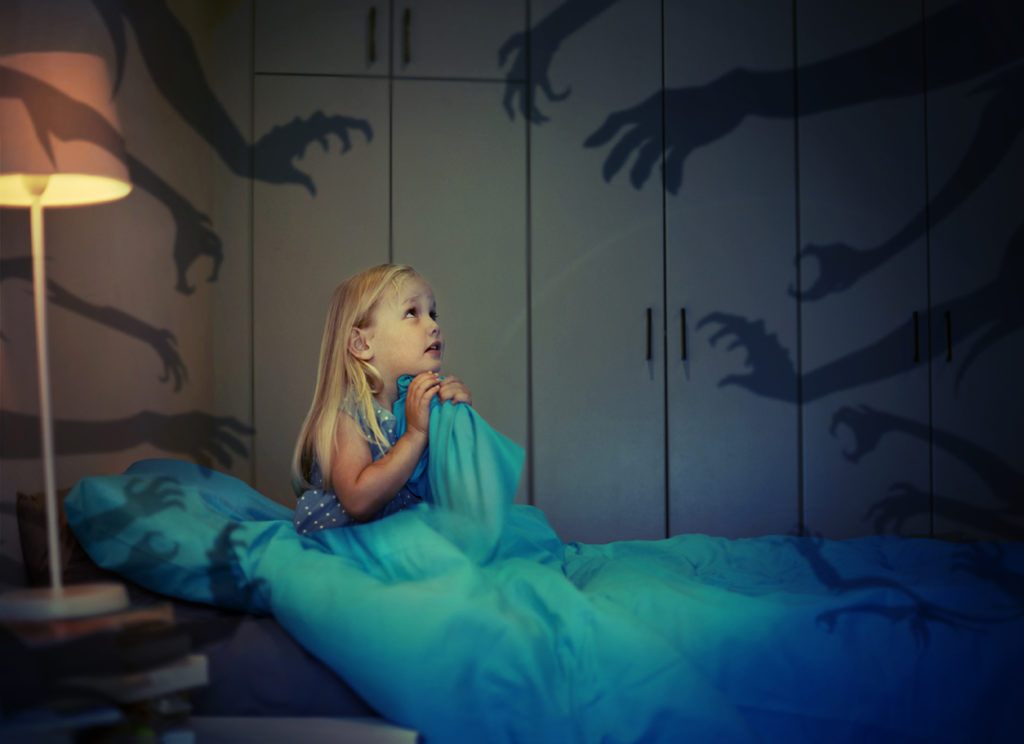
A wail for “mommy!” and pitter-pattering feet in the hall. Many parents know the sounds of sleep disturbances. Sometimes, dreams get scary, and children turn to parents for comfort.
On average, people dream about two hours per night. SleepFoundation.org offers some theories about why we dream, including building memory, handling emotions, purging unnecessary information, analyzing recent events or processing incidental brain activity. Bad dreams that wake the sleeper are considered nightmares.
Janet Lam, a neurologist at Kennedy Krieger and assistant professor of neurology at Johns Hopkins School of Medicine, and Paige Seegan, a postdoctoral fellow in the Pediatric Medical Psychology Program at Johns Hopkins School of Medicine, share insight about the frightening things that lurk in children’s dreams.
Nightmares vs. night terrors
Initially, parents may not know what they’re up against. “Night terrors, sleep terrors and parasomnia happen during non-REM (rapid eye movement) sleep,” Seegan explains. “They last a few minutes and can be very stressful. The child looks to be in distress, isn’t acknowledging the parent and doesn’t remember (the event).” The National Sleep Foundation notes that up to 40% of children younger than age 5 have had at least one night terror. “It may be the next day that the parent realizes the child has no idea he or she had the sleep terror, even if (the child) has been kicking and screaming,” says Lam. “The night terrors happen in lighter sleep (the first 60 to 90 minutes).”
On the other hand, “nightmares happen during deeper REM sleep cycle (final stages) in the middle of the night or early morning,” Seegan says. The child can realize a parent is present, answer questions, follow commands and remember the dream after it occurs.
Age of onset
Nightmares emerge around age 3. Seegan says that roughly half of children ages 3 to 6 report nightmares, and 20% to 25% between ages 6 to 12. Nightmares tend to drop in frequency around adolescence.
“Parents start hearing about nightmares when children are toddlers and preschool age,” Lam explains, “maybe because the child is more mobile to come to parents or maybe because (the child is) more imaginative but unsure of what is reality.”
Common themes
Seegan hears tales of monsters, stories about being chased and threats to safety as typical elements in scary dreams. If a child is being mistreated or has experienced trauma, feelings associated with these events may creep into dreams. “Parents can talk with their child about dreams to see if there is a pattern, even journal it,” suggests Lam. “Drawing can help the child convey what is happening. If parents become aware of stressors, they can address those.”
Parents can offer comfort. “Use imagination to empower them … ‘magic pajamas’ or whatever makes them feel secure,” suggests Seegan.
“If a child has nightmares that something is chasing him or her, maybe the child becomes a superhero,” adds Lam. “If you can change the ending, sometimes the nightmares go away.”
Triggers for bad dreams
Seegan cautions that stress, anxiety, trauma and contextual primers such as movies can trigger nightmares. Sleep deprivation and poor sleep can also lead to night terrors. “Within the first month after a traumatic event, it is normal to have nightmares. If they continue, seek help processing the trauma during waking hours.”
“Conflict or bullying, changes in routine and divorce can trigger nightmares,” says Lam. Parents should be aware of the media kids are consuming as well. “Kids have access to so much right now,” she warns, “YouTube, ads, things they can click and go to easily.” Lam adds that some medications, such as Benadryl, anti-anxiety drugs, or melatonin, can potentially lead to nightmares for some kids.
“If you are taking melatonin to help with initiating sleep, then you may sleep more, thus increasing opportunity for more REM sleep and potentially vivid dreams, but there isn’t evidence that melatonin causes nightmares,” expands Seegan. “Melatonin is a naturally occurring hormone we make to get ready for sleep.” Here’s an optimal way to take the supplement, if necessary: Take melatonin 30 minutes before bed, then avoid screens.
Fostering independence
“Kids create sleep onset associations,” says Seegan. “The way we fall asleep in the beginning of the night is the way we want to fall asleep. Keep the environment consistent.”
“In the sleep clinic, we focus on children being able to fall asleep independently so they can get back to sleep independently,” Lam explains. “During the night, we wake up, roll over, pull the covers up and go back to sleep. If we wake up and things are very different, it can be alarming. It’s like if you fell asleep and then woke up outside! If kids fall asleep snuggled with a parent and then wake up and the parent is not there, or are in a different room, or the soft music isn’t playing anymore, they feel they need those things back to get back to sleep.”
If your child shows up at your bedside after a nightmare, “try walking (your child) back to his or her own room so that (your child) doesn’t get the impression that the room is not a safe place to sleep,” advises Lam.
Encouraging positive sleep
Seegan promotes a regular bedtime and waking schedule for her patients. “A sleep routine can be as simple as ‘brush teeth, bathroom, pajamas and 15-minute story.’ Have a little snuggle time; talk about positive things that happened that day or things to be looking forward to, rather than thinking about negative things before bed.” Lam notes that parents can seek a specialist’s help if a child’s sleep disturbances become a struggle every night, if the child’s daytime functioning is impaired due to tiredness or if parent sleep is impacted too.
Sleep disturbance “has been a concern for so many families during this last year,” says Seegan. “I’ve done sleep hygiene recommendations with every patient I’ve seen because it has been such an ongoing challenge.”









Si bien llegar a tener pesadillas de forma esporádica es algo común, lo cierto es que de presentarse de forma recurrente provocan que la higiene del sueño se vea afectada, lo que puede reflejarse negativamente en la calidad de vida y en la salud integral.